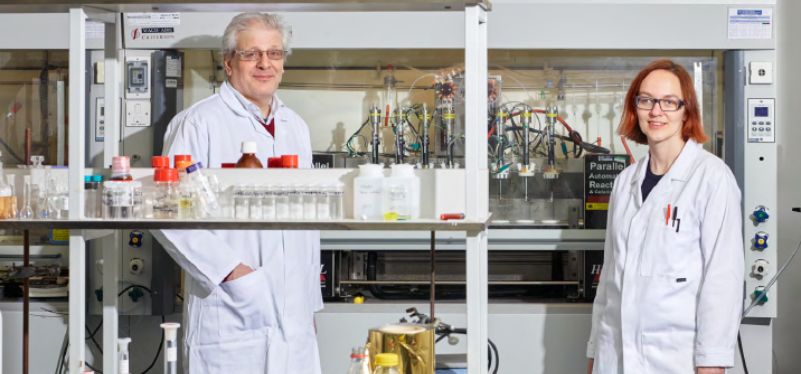Plastic People
Professor Gosia Swadźba-Kwaśny and Professor John Holbrey have big ideas for recycling.

CONTEXT
Our planet is in danger of being overwhelmed by plastic pollution. Plastics are amazing and useful materials that revolutionised all aspects of our lives, but the way we use them is broken. An item that may only be used for a matter of seconds can hang around for hundreds of years because most single-use plastics are not biodegradeable. Seventy-nine per cent of plastic waste is sent to landfills or ends up dumped in the ocean, 12 per cent is incinerated, while only nine per cent is recycled. Finding a sustainable solution to its disposal is one of the most pressing environmental concerns of our age.
BACKGROUND
Currently, plastic waste can be recycled mechanically by melting and remoulding its raw materials – the polymers – to create new products. “But this is a limitedtime process,” says Professor Gosia Swadźba-Kwaśny from the Queen’s University Ionic Liquid Laboratories (QUILL) Research Centre. “The material’s mechanical strength and quality deteriorates every time it’s reprocessed – over just a few cycles a clear plastic bottle would become weaker and turn black.” So Swadźba-Kwaśny’s team is exploring how chemical rather than mechanical processing can recycle plastic consistently –and infinitely. “Our chemical process takes the plastic right back to tiny molecules, cleans them and enables products to be made that are as good as, and possibly even better-quality than, the original ones,” she says. The goal is to keep atoms and molecules infinitely in use for rebuilding with the same quality – “like building a Lego model and then breaking it down to use its individual bricks again and again and again.”
METHOD
Swadźba-Kwaśny is looking into waste polyolefin plastics that have been broken down into smaller fragments using pyrolysis (heating without oxygen), and designs ionic liquids that convert these smaller fragments into high-value products, such as oils and waxes. Her colleague, Professor John Holbrey, is leading research on recycling PET (polyethylene terephthalate) plastics through depolymerisation, the treatment of waste with a chemical reaction to break it down to its constituent monomers, which can be cleaned up and converted back to PET.
FINDINGS
“We’ve found that at the usual temperatures you’d use to depolymerise PET, our catalysts have conversion rates that are 50 per cent better. That opens up the possibility of running the process at lower temperatures, making this form of recycling cheaper and less energy-intensive. That offers a whole new world of possibilities,” says Holbrey.
OUTCOMES
Crucially, the findings of both teams lead to forms of recycling that can be done on a smaller, more localised scale. “It is not sustainable to manage plastics with huge facilities,” explains Professor Swadźba-Kwaśny, “because it involves a lot of transportation and a huge carbon footprint. Our findings could be applied as different technologies in different places – cleaner, small, aesthetic facilities. The recycling process itself is helping the planet, but the possibilities it opens up bring an economic and environmental benefit that’s wider than just the product itself.” And the cross-disciplinary work she’s undertaking will, she hopes, improve waste movement across Northern Ireland.
Professor Gosia Swadźba-Kwaśny is the Director of the QUILL Research Centre (Queen’s University Ionic Liquid Laboratories, the oldest and most established centre dedicated to studying ionic liquids and their analogues).
Professor John Holbrey is Chair of Green Chemistry and a member of QUILL.